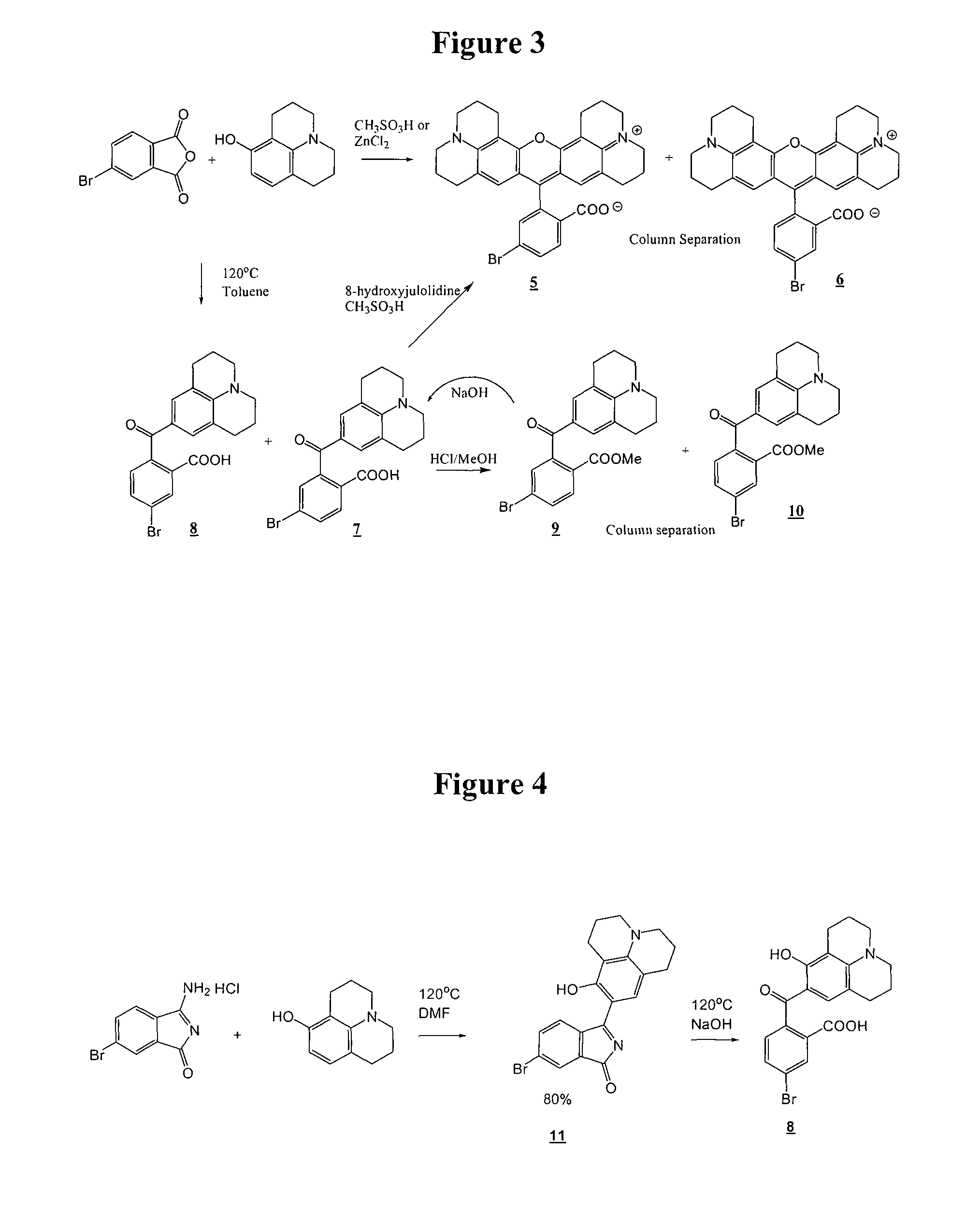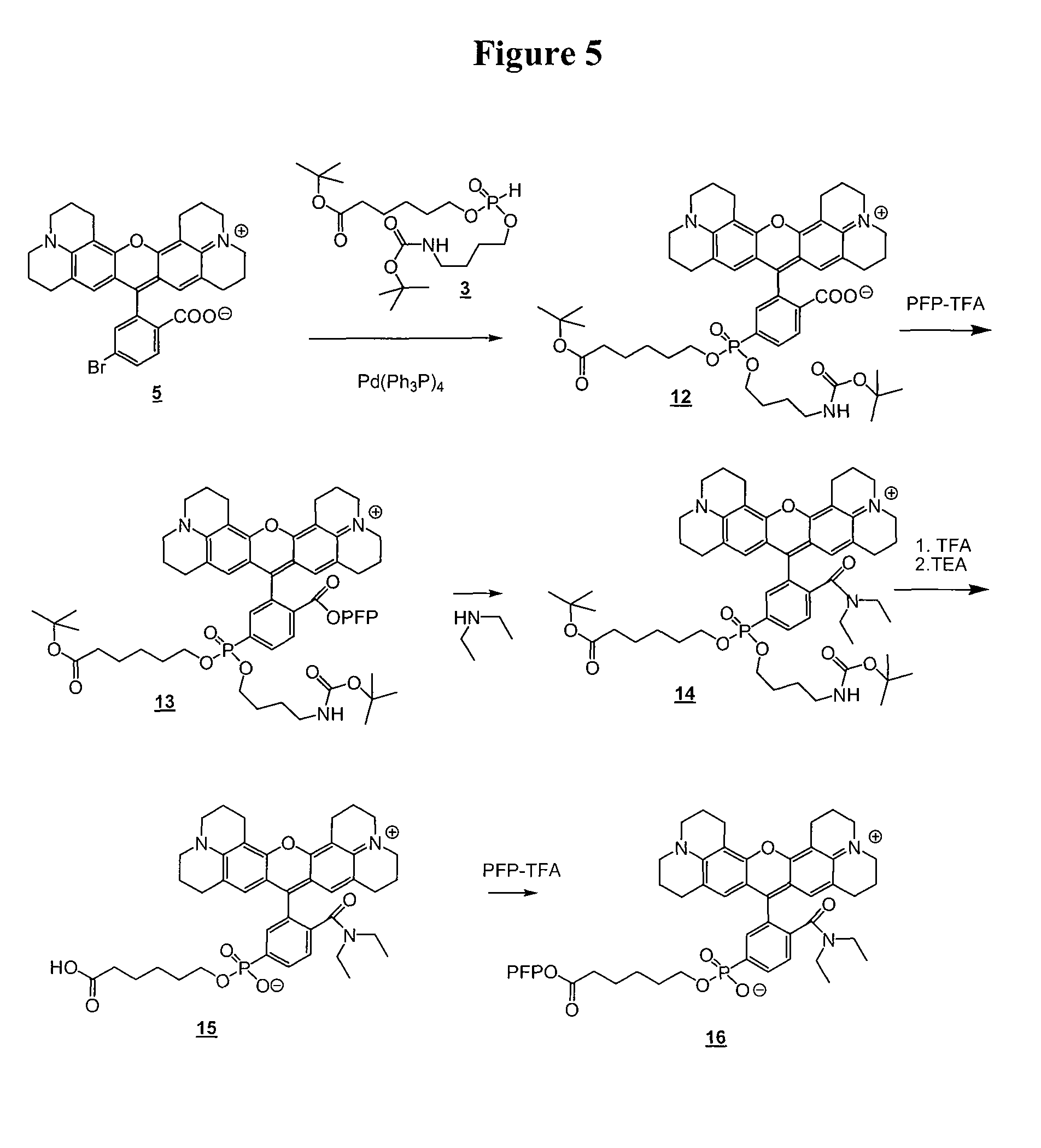Amide-substituted xanthene dyes
a technology of xanthene dye and amide, which is applied in the direction of peptides, peptide/protein ingredients, peptide sources, etc., can solve the problems of complex activation of functional groups such as cooh, oh (which, chlorides, etc., and activated esters or various dehydrating agents
- Summary
- Abstract
- Description
- Claims
- Application Information
AI Technical Summary
Problems solved by technology
Method used
Image
Examples
example 1
Preparation of tert-Butyl 6-{[oxido(3′-{(tert-butoxycarbonyl)amino}butyl)phosphino]oxy}hexanoate (3)
[0178]This example demonstrates the synthesis of the novel phosphonylation reagent 3 as shown in Reaction Scheme 1.
[0179]To a solution of tert-butyl 6-hydroxyhexanoate (1) (J. Org. Chem. (1984), 49(12), 2147) (2.6 g, 13.7 mmol) and tert-butyl 4-hydroxybutylcarbamate (2) (J. Med. Chem. (2006), 49(14), 4183-4195) (2.6 g, 13.7 mmol) in 20 mL of anhydrous pyridine (20 mL) was added 3.1 mL of diphenylphosphite (85% pure). After being stirred at room temperature overnight, the reaction was concentrated and re-dissolved in ethyl acetate. The solution was washed with 10% citric acid, saturated NaCl and dried over Na2SO4. The crude material obtained after solvent evaporation was chromatographed on silica eluting first with 1:1 ethyl acetate:hexane to separate phenol and one of the symmetric by-products and, second, with ethyl acetate to elute the desired phosphite 3. Concentration of the pure ...
example 2
[0180]This example demonstrates preparation of isomerically pure bromo-substituted rhodamine dyes as shown in Schemes 2 and 3.
Synthesis of Bromo-Substituted Dyes (5) and (6).
[0181]A mixture of 8-hydroxyjulolidine (10 g, 52.8 mmol), 4-bromophthalic anhydride (4.8 g, 21.1 mmol), propionic acid (75 mL) and methanesulfonic acid (0.5 mL) was heated at reflux for 22 hrs. The resultant dark mass was dissolved in dichloromethane (˜1 L), washed with water, saturated sodium chloride and dried over Na2SO4. The solution was concentrated to give a crude mixture of 5 and 6. The isomers were separated by three repetitive silica gel chromatographies eluting with a gradient of MeOH (0 to 15%) in dichloromethane. Concentration of the faster eluting product and slower eluting product afforded 2.56 g of compound 6 and 3.72 g of compound 5, correspondingly. (5) H1-NMR (DMSO-d6): δ 7.90 (d, J=8.7 Hz, 1H), 7.83 (dd, J1=8 Hz, J2=1.5 Hz, 1H), 7.44 (d, J=1.5 Hz, 1H), 6.20 (s, 2H), 3.24 (m, 4H), 2.88 (t, J=6 ...
example 3
Preparation of Compound 12
[0188]A mixture of bromo-substituted dye 5 (0.85 g, 1.5 mmol), DMF (2.2 mL), N-ethylmorpholine (1 mL, 7.9 mmol) and phosphate 3 (1.27 g, 3 mmol) was degassed under vacuum for about 3 min. Tetrakis(triphenylphosphine)palladium(0) (0.12 g, 0.1 mmol) was added and the reaction was heated at 70° C. with stirring for 3 h. The reaction was cooled diluted with 10% MeOH in dichloromethane and loaded on a silica gel column with had been pre-equilibrated with the same solvent mixture. Elution with a gradient of MeOH (10→30%) in CH2Cl2 followed by concentration of the pure product fractions afforded 0.65 g of the desired phosphonate-substituted dye 12 as an amorphous solid.
Preparation of Compound 15.
[0189]Compound 12 (0.6 g, 0.66 mmol) was dissolved in 10 mL of anhydrous DMF and treated with 0.5 mL (3.6 mmol) of triethylamine followed by 0.2 mL (1.16 mmol) of pentafluorophenyl trifluoroacete (PFP-TFA). The reaction mixture immediately changed its color from blue-purpl...
PUM
| Property | Measurement | Unit |
|---|---|---|
| pH | aaaaa | aaaaa |
| temperature | aaaaa | aaaaa |
| temperature | aaaaa | aaaaa |
Abstract
Description
Claims
Application Information
 Login to View More
Login to View More - R&D
- Intellectual Property
- Life Sciences
- Materials
- Tech Scout
- Unparalleled Data Quality
- Higher Quality Content
- 60% Fewer Hallucinations
Browse by: Latest US Patents, China's latest patents, Technical Efficacy Thesaurus, Application Domain, Technology Topic, Popular Technical Reports.
© 2025 PatSnap. All rights reserved.Legal|Privacy policy|Modern Slavery Act Transparency Statement|Sitemap|About US| Contact US: help@patsnap.com



